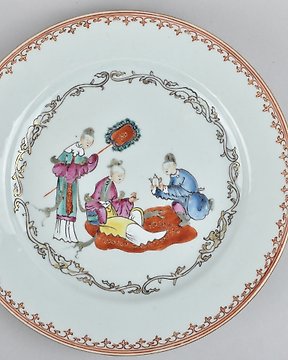
Plato - decorado con damas chinas - Porcelana - China - Qianlong (1736-1795)
N.º 82175025

N.º 82175025

A Japanese Kakiemon-style bird, quail and Three friends of winter dish. Painted by by a Dutch painter to decorate a Chinese porcelain blank.
The scene and quality of paintting is amazing.
Three Friends of Winter
These are pine, Prunus mume and bamboo. Both the pine and the bamboo remain green throughout the winter, while the early blossoms of the Prunus mume
are harbingers of spring. In China the combination of the positive characteristics attributed to each motif represented the ideal character of the Confucian scholar
They became a subject in Japanese painting in the 15th century, and are also found on kakiemon porcelain. The rounded surface of a porcelain bowl lends
itself beautifully to their depiction, allowing them to unfold around the surface. The many imitations by European manufacturers bear witness to the popularity
of this motif in Europe.
Bird (Magpie)
Prominently present in many kakiemon designs is a tree branch with one or two birds. These birds are hard to identify: they may not be representations of actual
species, although most bear some resemblance to bush warblers. It is probable that these images can be traced back to Chinese illustrated books and/or paint-
ings by the Kano School. This motif seems to have been well received in Europe. since it was taken up as an exotic subject', whereby the branch with the bird
assumed emblematic characteristics.
Quail (uzura) and millet (owol)
Judging by the number of European imitations, this was one of the most popular motifs. The design and the painting style used on kakiemon porcelain show a great
similarity to Tosa School paintings of this subject, which in their turn follow Chinese examples (see pp. 139-141). The combination is a frequently employed reference to
autumn.
reference;
Kakiemon porcelain, menno Fitzki
Condition
Some fritspots/small chips at rim, 1 tiny glaze line at rim only visible at front. 1 tiny piece restuck underside rim. Size 280x40mm Diameter x Height
Period
18th century Qing (1661 - 1912)
Cómo comprar en Catawiki
1. Descubre algo especial
2. Haz la puja más alta
3. Paga de manera segura